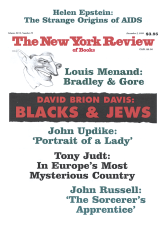In response to:
Persuading the Persuaded from the September 23, 1999 issue
To the Editors:
My American Sermons: The Pilgrims to Martin Luther King is based on a simple if unfamiliar idea: that the vast and rich tradition of American sermons can be read for literary interest, by readers neither committed to the authors’ beliefs nor familiar with the details of religious history. Reviewing it [NYR, September 23], Edmund Morgan declares it possible “to see the sermon as a literary genre and read it as such, but its importance in American history was not literary.” This is as close as Morgan gets to understanding the idea of the sermon as a literary genre: just close enough to brush it aside, evidently wishing he had been given a documentary history of religion instead.
Must readers of sermons read only for historical importance? Doesn’t literary history have its own importance? Morgan spends most of his review blaming the book for his apparent incuriosity about the genre, affecting to find the criteria of selection mysterious, and making a great pantomime of scratching his head about those criteria from the beginning to end. He notes that sermons are not included simply because they are famous, or because they were important in some doctrinal controversy, or because they converted many hearers. Anyone familiar with the concept of a literary anthology, or the mission of the Library of America, might have taken this as obvious. To Morgan the fact that “historical or theological significance has obviously not been Warner’s criterion” can only mean that the selections are “offbeat,” “arbitrary,” and “strange.” He then proceeds to show at length what no one ever doubted: that other sermons are more historically or theologically important.
That other sermons by Cotton Mather are better evidence of his chiliastic doctrine than the two included does not mean that they would be better reading. If anything, it explains why they were not selected. George Whitefield was a legendary preacher but his famous siren voice must have had an awful lot to do with it, because even such sermons as “The Almost Christian” sit flat on the page. It is for this reason, and not for any quibble about his nationality, that he was excluded. William Ellery Channing’s “Unitarian Christianity” may be more important to annalists of Unitarianism than “Likeness to God,” but “Likeness to God” is the more eloquent text, as I think anyone who reads them will agree. No one doubts the popularity or historical importance of Charles Grandison Finney, but like Whitefield he left behind texts that are surprisingly dull and orthodox.
Morgan sounds shocked that I included nothing from “the great Methodist preachers of the early nineteenth century,” but I suspect that like most historians he is relying on secondhand reputation rather than on familiarity with the surviving texts. He worries that Emerson’s Divinity School Address is a greater event in the history of ideas than the sermon with which Emerson resigned his pulpit six years earlier; he forgets that this “address” is well along in the formal transition from sermon to essay, coming near the point when Emerson’s discontent with the form led him to repudiate preaching altogether. Morgan complains that the volume does not document abolition, immigration, or labor disputes, as though this were the task of an anthology of genre. And so it goes: in a review full of detailed complaints, not one of Morgan’s criticisms hits home, because not once does he entertain a literary argument.
Like any reader, Morgan is welcome to dispute this or that selection. There is no canon for this genre and precious little literary criticism on which to base one, and therefore more than usual opportunity for argument. But he should make his case on literary grounds, especially if he wants to argue that sermons are poor in literary interest. He does not even attempt to do so.
The real challenge of American Sermons, one to which a more creatively disposed reviewer might have risen, is to describe the distinctive qualities of the genre, or its changes over time. The sermon has a range of eloquence that no other literary form can rival, though novelists, poets, playwrights, and secular orators have never stopped trying. Compiling an anthology of sermons requires one to think about the special nature of sermonic eloquence; the boundaries of the genre; the readability of texts for nonspecialists; the inclusion of subgenres (execution sermons, funeral sermons, election sermons, etc.); the range of styles; and the shape of tradition, which in this case means the extraordinary consistency of form for the first two centuries, followed by a dramatic diversification in the last two.
The British have a long history of reading their sermons as literature. In America, where the sermon has been more consistently cultivated, more varied in development, more influential on writers in other genres, and more central to the culture in general, we have not done so. The aversion to religion in cultural studies may be partly to blame, but so is the historian’s or theologian’s reflex of disciplinary defensiveness, kicking out so sharply in Morgan’s review. I can only imagine that the intensity of Morgan’s identification with historical scholarship has blinded him to the possibility of any other kind.
Michael Warner
Professor of English
Rutgers University
New Brunswick, New Jersey
Edmund S. Morgan replies:
I am happy to learn that Professor Warner’s criterion for selecting sermons lay in their literary merit. I confess that I considered that possibility and dismissed it, because the literary qualities of the sermons chosen did not seem to me to place them among other examples of “America’s best and most significant writing.”
This Issue
December 2, 1999



